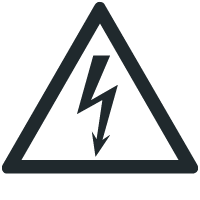Restrictions
- It is to be noted that if the drive does not have a mechanical brake or if the brake is defective, the drive may coast to a halt (depending on the friction and mass moment of inertia of the system). In the event of regenerative loads or with axes that are loaded with gravitational forces or driven externally, the drive can even accelerate. This must be taken into account in a risk assessment of the system/machine. Additional safety measures might have to be implemented (e.g. safety brake system).
- In the case of application-related safety sub-functions that require stopping the hazardous motion safely, an additional safety brake system may be necessary on an application-specific basis.
- When using the function SS1-t, the deceleration ramp of the drive is not monitored with respect to safety. In the case of an error, the drive might not be decelerated during the delay time, or the drive can accelerate in the worst case. In this case, the safety-related deactivation via the STO function is only activated after the set delay time has passed. The resulting hazard must be taken into account in the risk assessment of the system/machine and may need to be covered through additional safety measures, if necessary.
- The STO function cannot prevent a possible jerk or DC braking.

WARNING

When the STO signal is disconnected, voltage is still present at the DC link of the device.
Death or severe injuries
- Before working on the electric part of the drive system, disconnect it from the supply voltage using an appropriate external disconnecting device and secure it against unintentional reconnection.

WARNING

Electric shock due to incompletely discharged capacitors.
Severe or fatal injuries.
- Observe a minimum switch-off time of 10 minutes after disconnecting the power supply.
INFORMATION
